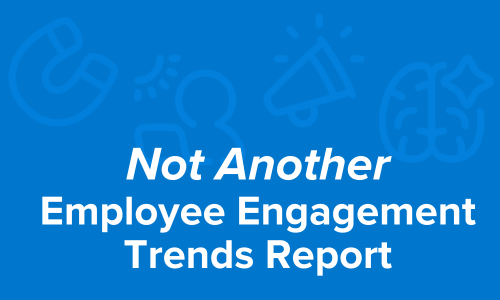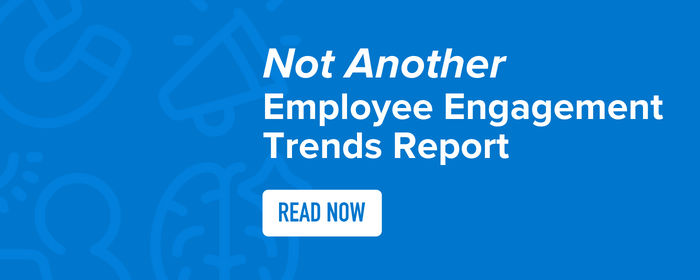Addressing Employee Burnout: 9 Trends Impacting Employee Success
The implications of employee burnout are key for organizational leaders to understand in the modern workplace. The World Health Organization has spotlighted burnout not as a medical condition but as a critical consequence of unmanaged workplace stress. Our leader researcher, Shane McFeely, unveils in our latest research that burnout is not merely disengagement, but a precursor to it. It stems from relentless demands, scarce resources, and inadequate employee recognition—factors that can sideline even the most committed employees.
Every team member is at risk for burnout. Without intervention, even high-performing teams can disengage and lose their alignments with your organization's most important goals. Our 2024 Not Another Employee Engagement Trends Report dives deep into these issues, presenting new data on employee burnout and offering actionable strategies for organizations to revive their culture, reenergize their teams, and point everyone in the direction of employee and business success.
Understanding employee burnout in today's workplace
Job stress and burnout are increasingly common in our high-speed, high-stress work environments, where the relentless demands of work often overshadow employees' mental and emotional well-being. Burnout manifests through deep-seated exhaustion, growing cynicism toward job roles, and a start decline in professional effectiveness.
Early recognition of burnout is essential for timely intervention. Signs to watch for include:
- Overwhelming fatigue
- A disconnection from one's work
- Dwindling job satisfaction
- A reduced sense of personal achievement
By pinpointing employee burnout contributors, such as inadequate communication, and addressing them proactively, organizations can foster a work environment that supports rather than drains, promoting employee health and job satisfaction.
The latest research findings on employee burnout
Recent studies underscore the persistent challenge of employee burnout in today's workplaces, confirming its widespread impact across industries. Christina Maslach, a leading authority on burnout, identifies detrimental work environments—characterized by long hours, overwhelming workloads, and limited control over work—as primary contributors to this condition. Despite growing awareness, many employees still report a significant lack of purpose and fulfillment, which precipitates mental disengagement and burnout.
This troubling trend not only signals the need for environments that nurture purpose and support but also emphasize the importance of promoting a healthy work-life balance. In line with these findings, our own research delves deeper into the mechanics of burnout, revealing critical insights that can help organizations craft more resilient and supportive workplace cultures.
1. Burnout is still common in workplaces.
Despite increased awareness and efforts towards employee well-being, burnout remains prevalent in today's workplaces. Our research shows 37% of employees report high burnout rates. This level has decreased since 2021, but still means more than 1 in 3 employees are consistently experiencing burnout. When burnout is prevalent in your organization, it hinders individual and team performance.
2. Burnout impacts employee engagement and retention.
Employee engagement and retention within your organization are closely tied to the well-being of your employees. When burnout permeates the workplace, it not only affects individual mental health but also poses a significant risk to the overall morale and productivity of the team. Organizations will need to address burnout to prevent disengagement and turnover.
Our research shows employees with high burnout are:
- 1.7X less engaged
- 1.6X less likely to say it’d take a lot to get me to leave
- 1.4X less likely to say they intend to stay for the next year
- 2.1X more likely to be searching for other jobs.
3. Leadership feels burnout too.
Your leaders are equally susceptible to the strains of burnout. Our research shows that managers and directors report higher rates of burnout than their executive or entry-level counterparts. This group, burdened with significant responsibilities, often receives less recognition for their efforts, making them particularly vulnerable to burnout. Addressing this gap is crucial for maintaining a balanced and supportive workplace.
4. Employee burnout rates are highest in Software & IT.
In the dynamic Software & IT sectors, burnout rates are notably high. Our research shows 47% of Software & IT employees report experiencing it—significantly higher than in other sectors, where rates fall below 40%. The pressure to innovate and meet demanding deadlines, coupled with the need to continuously update skills in line with rapidly evolving technologies, can place a lot of stress on employees.
Additionally, burnout can intensify seasonally in certain industries, such as during tax season or amidst the rush to meet major project deadlines, further emphasizing the need for targeted interventions across different times and industries. Hear from our Senior Insights Analyst, Rachel Hudson, on how organizations in Professional Services & Accounting are addressing employee burnout.
5. Younger employees have higher burnout rates.
Research indicates that younger employees often experience higher burnout rates, driven by career uncertainties, the pressure to excel, and the challenges of adapting to fast-changing work environments. Balancing demanding job expectations with personal life can intensify their stress and exhaustion, heightening their risk of burnout.
It's crucial for employers to understand the specific challenges faced by this demographic and respond with supportive measures such as flexible work policies, mentorship opportunities, and targeted mental health resources to promote a healthier work culture. Our research shows almost half of employees aged 26 to 35 reporting high levels of burnout, in contrast to just 29% of those aged 56 to 64. Recognizing and addressing these significant differences in burnout rates is essential for catering to the diverse needs of various age groups within the workforce.
6. New and tenured employees are less likely to experience burnout.
Starting a new job comes with its challenges, yet interestingly, burnout isn't always highest among the newest employees. In fact, those who have been with their organization for less than a year or more than 15 years report the lowest levels of burnout, at about 31% and 30% respectively. This phenomenon may be attributed to the initial enthusiasm and lower immediate expectations for new hires, allowing them to ease into their roles without the same pressure faced by their more established colleagues.
On the other end, employees with over 15 years of tenure have likely developed effective coping strategies and have a thorough understanding of their roles and the organizational culture, which helps mitigate stress and reduce burnout risks. However, it remains crucial for organizations to support these employees continuously to sustain their mental health and prevent burnout. Building a supportive work environment and utilizing an employee listening strategy are vital in understanding and addressing the needs of employees across different tenure levels, reinforcing resilience within the team.
7. Insufficient training is a leading cause of burnout.
Research indicates that inadequate training is a significant factor contributing to employee burnout. Employees who feel ill-equipped to handle their job responsibilities can quickly become overwhelmed, resulting in stress and burnout. Providing thorough training not only gives employees the necessary skills to perform effectively but also boosts their confidence and satisfaction with their roles. Therefore, organizations must prioritize comprehensive training programs to mitigate burnout and improve overall employee well-being.
Additionally, sufficient staffing is crucial for managing workload effectively. According to surveys, only two out of five employees believe their organization has enough staff to manage current work demands. Adequate staffing levels are essential for preventing burnout by ensuring that workloads are distributed fairly, thereby reducing the risks of employee turnover and disengagement. By focusing on these areas, companies can foster a supportive environment that promotes both individual growth and collective resilience.
8. Managing burnout requires organizations to act on employee feedback.
To effectively tackle employee burnout, organizations must prioritize capturing and acting on valuable insights from their employees. An employee listening strategy can help companies detect early signs of burnout, allowing them to proactively develop strategies to counteract its effects. Establishing open lines of communication creates a safe space for employees to voice concerns and offer suggestions, thereby cultivating a supportive workplace culture. Feedback mechanisms and loop-back processes are crucial for HR and leadership to tailor interventions that meet the specific needs of their workforce, enhancing mental health and overall well-being.
Burnout can stem from various sources. Employees who report having manageable stress levels, supportive workplace cultures, sufficient staffing, and fair compensation and benefits are significantly less prone to experiencing burnout. Regularly soliciting employee feedback, analyzing this data, and implementing meaningful changes based on these insights are key steps in addressing and preventing burnout before it escalates.
9. No, AI doesn't reduce burnout.
Artificial Intelligence (AI) has transformed many workplace functions, yet its capability to address employee burnout is limited. While AI excels at automating tasks and optimizing processes, it lacks the emotional intelligence and personal touch needed to effectively mitigate the mental health aspects of burnout. Employees require real support, empathy, and a positive work environment—elements that AI cannot provide. Although AI can boost productivity, it is not a comprehensive solution for reducing burnout.
In fact, higher burnout rates are reported among frequent AI users. This may suggest that employees turn to AI to increase efficiency in response to being understaffed, which in itself can contribute to burnout. Thus, while AI has its benefits, it does not replace the need for sufficient human staffing and genuine interpersonal support to prevent burnout.
4 things HR can do to address worker burnout now
It’s important to foster an engaging and supportive culture that acts quickly on reducing burnout. To act quickly and stay ahead of burnout, help employees feel valued and connected to the organization with these steps.
1. Continuous employee listening
Quantum Workplace research reveals that engagement can surge by up to 40% with a continuous listening strategy. However, it's crucial to understand that insights alone are merely data points. Real improvement in engagement requires organizations to act on these insights, not just collect them. When developing or refining your continuous listening strategy, consider the following:
- Survey cadence. Our findings indicate that regular surveying correlates with higher engagement levels.
- Communication. Implement a communication plan that ensures clarity before, during, and after the surveys to keep everyone informed and engaged.
- Action on insights. Merely gathering survey data won't enhance employee engagement. It's essential to use the feedback to implement substantive changes that improve the overall employee experience.
2. Meaningful 1-on-1 conversations
Continuous performance management and regular one-on-one meetings position managers as performance coaches, transforming the traditional performance review into a more effective and engaging process. Here’s how to implement a continuous performance management approach:
- Secure leadership buy-in. Ensure leadership understands and supports the strategy and its potential impact.
- Establish a clear framework. Outlines clear objectives and expectations for performance management.
- Train leaders and teams. Provide comprehensive training to ensure everyone is equipped to succeed.
- Continuously improve. Regularly assess and refine the performance management process.
3. Clear Goals and Alignment
Simply setting goals for employees and the organization is not sufficient. It’s crucial that these goals are realistic and consistently aligned across individual, team, and organizational levels. Making key goals visible ensures that employees understand which aspects of their workload are most critical and should be prioritized. To effectively align goals throughout your organization, consider the following steps:
- Define clear organizational goals. The more precise and understandable the goals, the easier it is for everyone to grasp the organization's vision.
- Engage leadership. Secure buy-in from senior leadership and managers, encouraging them to provide feedback and ask questions to ensure that the goals are coherent and actionable.
- Communicate goals at all levels. Integrate goal discussions into leadership and team meetings, one-on-ones, and performance reviews. Aim for consistent and clear communication throughout every level of the organization.
- Support employees in achieving goals. Provide employees with the necessary ongoing training, resources, and regular feedback and coaching from their managers to help them succeed in meeting their objectives.
4. Employee Recognition
Employee recognition is crucial in preventing burnout. Employees facing heavier workloads particularly appreciate acknowledgment for their extra efforts, but consistent recognition is important regardless of circumstances. Feeling valued for their contributions can significantly enhance employee morale and commitment to organizational success.
Here are five tips for creating an effective employee recognition program:
- Be specific. Connect recognition to specific achievements or outcomes to make it more meaningful.
- Be prompt. Recognize great work soon after it happens rather than delaying appreciation.
- Align with company values. Highlight behaviors that embody your values and promote your ideal workplace culture.
- Celebrate all contributions. While it’s important to celebrate major achievements, also show appreciation for the smaller, everyday contributions that add up to big results.
Conclusion
Employee listening, continuous performance feedback, aligned goals, and recognition are essential tools in addressing burnout within your organization. Utilize our burnout research to monitor and develop effective strategies to prevent a culture of burnout.
For further insights into burnout and other factors affecting the workplace, explore our 2024 Not Another Employee Engagement Trends Report.
Frequently Asked Questions
What are the first steps in addressing employee burnout?
The first steps in addressing employee burnout involve recognizing the official definition of burnout, understanding the negative emotions associated with it, and identifying potential causes. This includes evaluating workload and turnover rates and taking proactive measures to address the root causes of burnout.
How can HR leaders influence change in their organizations?
HR leaders can influence change in their organizations by promoting employee well-being and addressing the factors that contribute to burnout. This includes implementing strategies to reduce absenteeism, addressing work-related headaches, and fostering a supportive work environment that prioritizes employee well-being and the well-being of their coworkers.
What are the long-term benefits of prioritizing employee well-being?
Prioritizing employee well-being can lead to long-term benefits for organizations, including increased resilience, higher morale, and improved employee engagement. Organizations that prioritize employee well-being experience higher productivity, lower turnover rates, and increased employee satisfaction, particularly among millennials.
| Work | My work motivates me. | My immediate coworkers consistently go the extra mile to achieve great results. | It would take a lot to get me to leave this organization. |
| Team | I find my work engaging. | My immediate coworkers are committed to this organization's overall goals. | I recommend this organization as a great place to work. |
| Organization | I am inspired by the work we do. | I feel accepted by my immediate coworkers. | I am proud to work here. |






